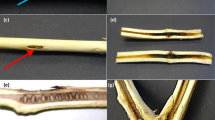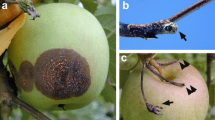Abstract
Chestnut rot is an important disease of chestnut trees in Oceania (Australia, New Zealand), and Europe (Italy, France, Switzerland, United Kingdom). The causal agent has been identified as the fungus Gnomoniopsis smithogilvyi (Gnomoniaceae, Diaporthales). Koch’s Postulates was demonstrated on nuts from three Australian chestnut varieties with G. smithogilvyi from Australia, New Zealand and Italy. The Australian and New Zealand isolates were pathogenic on all three varieties, however the Italian isolate produced smaller lesions on all three, and was only mildly pathogenic on Decoppi Marone. Infection of chestnut floral and vegetative tissues was investigated during the chestnut phenological stages of flowering (sampled twice over two years), immature nuts and burrs, mature nuts and burrs, and tree dormancy (immature nuts and burrs, mature nuts and burrs, and tree dormancy were sampled once in one year). Gnomoniopsis smithogilvyi was present in all the sampled phenological stages, most frequently from female flowers during the flowering period. In the first year, the fungus infected 82% of female flowers, while in the second year only 10% were infected. Ascospore trapping in a laboratory chamber experiment confirmed ascopores are released in to the air from infected burrs. Ascospore trapping in an Australian chestnut orchard during the flowering period also showed ascospores are released in to the air, with peak trapping times at sunset and the hours following sunset (8-11 pm), and the hours following sunrise (7-9 am). These experiments support the hypothesis that ascospores of G. smithogilvyi infect chestnut trees, particularly the flowers. The fungus then exists as a latent pathogen in reproductive and vegetative tissues, leading to the development of the disease during nut maturity.






Similar content being viewed by others
References
Botta R, Vergano G, Me G, Vallania R (1995) Floral biology and embryo development in chestnut (Castanea sativa Mill.) Hortscience 30:1283–1286. http://hortsci.ashspublications.org/content/30/6/1283.full.pdf
Carbone I, Kohn LM (1999) A method for designing primer sets for speciation studies in filamentous ascomycetes. Mycologia 91:553–556
Dar MA, Rai MK (2015) Gnomoniopsis smithogilvyi a canker causing pathogen on Castanea sativa: first report. Mycosphere 6:327–336
Darriba D, Taboada GL, Doallo R, Posada D (2012) jModelTest 2: more models, new heuristics and parallel computing. Nat Methods 9:772
Dennert FG, Broggini GAL, Gessler C, Storari M (2015) Gnomoniopsis castanea is the main agent of chestnut rot in Switzerland. Phytopathol Mediterr 54:199–211
EPPO (2016) First report of Gnomoniopsis smithogilvyi in the United Kingdom. European and Mediterranean Plant Protection Organization. EPPO Global Database. No. 11, 2016, article 2016/214. https://gd.eppo.int/reporting/article-5959. Accessed Mar 2017
Eskalen A, Faber B, Bianchi M (2013) Spore trapping and pathogenicity of fungi in the Botryosphaeriaceae and Diaporthaceae associated with avocado branch canker in California. Plant Dis 97:329–332
Felsenstein J (1985) Confidence limits on phylogenies: an approach using the bootstrap. Evolution 6:227–242
Huang HC, Kokko EG, Erickson RS (1999) Infection of alfalfa pollen by Botrytis cinerea. Botanical Bulletin of Academia Sinica 40:101–106
Huelsenbeck JP, Ronquist F (2001) MRBAYES: Bayesian inference of phylogenetic trees. Bioinformatics 17:754–755
Kumar S, Stecher G, Tamura K (2016) MEGA7: molecular evolutionary genetics analysis Version 7.0 for bigger datasets. Mol Biol Evol 33:1870–1874
Linaldeddu BT, Deidda A, Scanu B, Franceschini A, Alves A, Abdollahzadeh J, Phillips AJL (2016) Phylogeny, morphology and pathogenicity of Botryosphaeriaceae, Diatrypaceae and Gnomoniaceae associated with branch diseases of hazelnut in Sardinia (Italy). Eur J Plant Pathol 144:1–21
Lione G, Giordano L, SIllo F, Gonthier P (2015) Testing the effects of climate on the incidence of the emergent nut rot agent of chestnut Gnomoniopsis castanea. Plant Pathol 64:852–863
Meyer JB, Gallien L, Prospero S (2015) Interaction between two invasive organisms on the European chestnut: does the chestnut blight fungus benefit from the presence of the gall wasp? FEMS Microbiol Ecol 91(11):fiv122
Ngugi HK, Scherm H (2004) Pollen mimicry during infection of blueberry flowers by conidia of Monilinia vaccinii-corymbosi. Physiol Mol Plant Path 64:113–123
Ngugi HK, Scherm H (2006) Annual review of phytopathology. Annual Reviews 44:261–282
O'Donnell K, Cigelnik E (1997) Two divergent intragenomic rDNA ITS2 types within a monophyletic lineage of the fungus Fusarium are nonorthologous. Mol Phylogenet Evol 7:103–116
Ogilvy D (1998) Phomopsis when does it strike? The Australian Nutgrower 12:16–18
Pasche S, Calmin G, Auderset G, Crovadore J, Pelleteret P, Mauch-Mani B, Barja F, Paul B, Jermini M, Lefort F (2016) Gnomoniopsis smithogilvyi causes chestnut canker symptoms in Castanea sativa shoots in Switzerland. Fungal Genet Biol 87:9–21
Pinkerton JN, Johnson KB, Stone JK, Ivors KL (1998) Factors affecting the release of ascospores of Anisogramma anomala. Phytopathology 88:122–128
Rehner S (2001) Primers for elongation factor 1–α (EF1–a) www.aftol.org/pdfs/EF1primer.pdf
Reid A (2015) Gnomoniopsis fruit rot and leaf blotch of strawberries. Department of Agriculture and Food. Government of Western Australia. https://www.agric.wa.gov.au/strawberries/gnomoniopsis-fruit-rot-and-leaf-blotch-strawberries
Shuttleworth LA, Liew ECY, Guest DI (2012a) Survey of the incidence of chestnut rot in south-eastern Australia. Australas Plant Pathol 42:63–72. Published online 11 December 2012
Shuttleworth LA, Liew ECY, Guest DI (2012b) Fungal Planet description sheet 108: Gnomoniopsis smithogilvyi L.A. Shuttleworth, E.C.Y. Liew & D.I. Guest, sp. nov. Persoonia 28:142–143 http://www.fungalplanet.org/content/pdf-files/FungalPlanet108.pdf
Shuttleworth LA, Walker DM, Guest DI (2015) The chestnut pathogen Gnomoniopsis smithogilvyi (Gnomoniaceae, Diaporthales) and its synonyms. Mycotaxon 130:929–940
Smith HC, Ogilvy D (2008) Nut rot in chestnuts. The Australian Nutgrower 22:10–15
Stelfox D, Williams JR, Soehngen U, Topping RC (1978) Transport of Sclerotinia sclerotiorum ascospores by rapeseed pollen in Alberta. Plant Dis Rep 62:576–579
Taylor JW, Jacobson DJ, Kroken S, Kasuga T, Geiser DM, Hibbett DS, Fisher MC (2000) Phylogenetic species recognition and species concepts in fungi. Fungal Genet Biol 31:21–32
Tudzynski P, Scheffer J (2004) Claviceps purpurea: molecular aspects of a unique pathogenic lifestyle. Mol Plant Pathol 5:377–388
Vinale F, Ruocco M, Manganiello G, Guerrieri E, Bernardo U, Mazzei P, Piccolo A, Sannino F, Caira S, Woo SL, Lorito M (2014) Metabolites produced by Gnomoniopsis castanea associated with necrosis of chestnut galls. Chem Biol Technol 1:8
Visentin I, Gentile S, Valentino D, Gonthier P, Tamietti G, Cardinale F (2012) Gnomoniopsis castanea sp. nov. (Gnomoniaceae, Diaporthales) as a causal agent of nut rot of sweet chestnut. J Plant Pathol 94:411–419
Walker D, Castlebury LA, Rossman AY, Sogonov MV, White JF (2010) Systematics of genus Gnomoniopsis (Gnomoniaceae, Diaporthales) based on a three gene phylogeny, host associations and morphology. Mycologia 102:1479–1496
Walker DM, Castlebury LA, Rossman AY, White JF (2012) New molecular markers for fungal phylogenetics: Two genes for species-level systematics in the Sordariomycetes (Ascomycota). Mol Phylogenet Evol 64:500–512
White TJ, Bruns T, Lee S, Taylor J (1990) Amplification and direct sequencing of fungal ribosomal RNA genes for phylogenetics. In: Innis MA, Gelfand DH, Sninsky JJ, White TJ (eds) PCR protocols: a guide to methods and applications. Academic Press, San Diego, pp 315–322
Acknowledgements
We thank the University of Sydney, Horticulture Innovation Australia Ltd. and Chestnuts Australia Inc. for financial support. We thank the Royal Botanic Garden, Sydney and Mycotheca Universitatis Taurinensis, University of Turin, Italy, for providing cultures. Thank you to Mr. David Ogilvy for the use of his orchard for the isolation and spore trapping experiments, and to Simone Fouche, Forestry and Agricultural Biotechnology Institute (FABI), University of Pretoria for assisting with the pathogenicity testing.
Author information
Authors and Affiliations
Corresponding author
Rights and permissions
About this article
Cite this article
Shuttleworth, L.A., Guest, D.I. The infection process of chestnut rot, an important disease caused by Gnomoniopsis smithogilvyi (Gnomoniaceae, Diaporthales) in Oceania and Europe. Australasian Plant Pathol. 46, 397–405 (2017). https://doi.org/10.1007/s13313-017-0502-3
Received:
Accepted:
Published:
Issue Date:
DOI: https://doi.org/10.1007/s13313-017-0502-3




